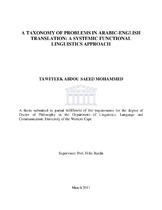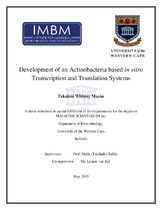| dc.description.abstract | Working with Arab students pursuing a degree in English Language and Translation at the Taiz
University, Republic of Yemen, has brought to the researcher‟s attention a number of errors or problems
encountered in Arabic to English translation. This study aims to investigate the problems encountered by
student translators (STs), novice translators (NTs) as well as more experienced translators (Ts) while
translating from Arabic into English. The study starts with the assumption that Arabic and English belong
to different families of languages and thus there is rarely a word-for-word equivalence in both languages.
The present study is cross-sectional in nature. It is based on empirical data collected from several
categories of translators. In other words, the data was collected from fourth-year students in the
department of English and Translation in the Faculty of Arts, Taiz University, as well as five
NTs who have previously graduated from this department and are currently working in a number
of accredited translation offices in Taiz. The study also investigates the challenges faced by Ts.
For this purpose, a novel, a tourist brochure, an editorial, and three academic abstracts all
translated by established publishing houses and translation centres in and outside Yemen are
examined. These texts are analyzed to determine to what extent the problems faced by STs and
NTs reoccur in published translations produced by Ts.
For its conceptual framework, the study adopts an eclectic approach that does not stick rigidly to
a particular paradigm but rather draws upon multiple linguistic and translation theories.
However, it is mainly based on Halliday‟s Systemic Functional Grammar (SFG) and the
problems have been classified along his taxonomy of meaning metafunctions into ideational,
interpersonal and textual. Extra-textual problems are also analyzed. Several SFG-based
translation models such as Hatim and Mason‟s (1990) sociometic model, House‟s (1977, 1997)
translation quality assessment model, Hervey et al. (1992) register analysis model and Baker‟s
(1990) equivalence model are also employed in the study to help the researcher examine the
problems encountered in Arabic-English translation within those four categories. In addition, Nord‟s functional model to translation which is based on Skopos theory is also taken into
consideration although to a minimum extent.
In addition to the analysis of translations produced by various categories of translators, the study
uses several triangulation research tools such as questionnaire, Thinking Aloud Protocols
(TAPs), retrospective interviews, and classroom observation. These tools are employed to assist
the researcher to identify the possible causes for the problems the STs, NTs, and Ts experience
from the perspective of the participants themselves. The current translation programme at Taiz
University is also analyzed to determine to what extent it contributes to the poor performance of
the student translators and would-be translators.
The study concludes that STs, NTs and even Ts encounter several problems at the ideational,
interpersonal and textual levels. They also encounter problems at the extra-textual stratum. The
study attributes these problems to structural and cultural differences between the two languages,
the reliance on the dictionary rather than the meaning in use of lexical items, the differences in
the cohesion and coherence systems of Arabic and English, the negligence of the role of context
in translation as well as unfamiliarity with text-typologies and genre conventions. In other
words, participants follow a bottom-up approach in translation and come close to the source text
translating it literally. This approach is very damaging because it ignores the fact that the three
metafunctions might be realized differently in the two languages.
Furthermore, the study concludes that the manner in which translation is taught at Taiz
University as well as the syllabus contribute mainly to the lack of translation competence of the
student translators and would-be translators. The programme is inadequate and it needs urgent
review and improvements. The present syllabus does not keep abreast with the latest theoretical
and practical developments in the discipline of translation as well as neighbouring disciplines
such as contrastive linguistics, text-analysis, discourse analysis, corpus linguistics and the like.
As for methodology, the study concludes that it is the transmissionist (teacher-centred) teaching approach rather than the transformational (learner-centred) which is commonly used in teaching
translation. As a result, the read-and-translate approach dominates the scene and no tasks,
activities, or projects are given to the STs.
The study provides some recommendations, which if implemented, can be useful in enabling
Yemeni and Arab universities to improve the competence among student translators in order to
improve translation teaching at academic level.
A major contribution of this study is the description and classification of translation problems in
Arabic-English translation on the basis of meaning systems. Unlike traditional descriptive error
analysis, which is widely used to analyze the translation product, SFG-based text analysis
provides a systematic description of translation problems which allows a precise articulation of
the nature of problems that would otherwise be explained simply as translations which “sound
unnatural or awkward” (Kim 2008; Yallop 1999). As far as the researcher knows, no study in
the Arab world has yet tackled translation problems from this perspective. Other studies have
tackled deviated forms produced by students or translators using an error analysis technique
rather than a holistic approach based on solid theoretical knowledge.
In other words, while most other studies focused on specific „errors‟ and error analysis and ended
at that, the present study does not only looks at „errors‟ as „difference‟ (from contrastive
analysis) but rather from several perspectives. It is also more comprehensive by triangulating
several sources of data and pooling them together for a more informed understanding. | en_US |




